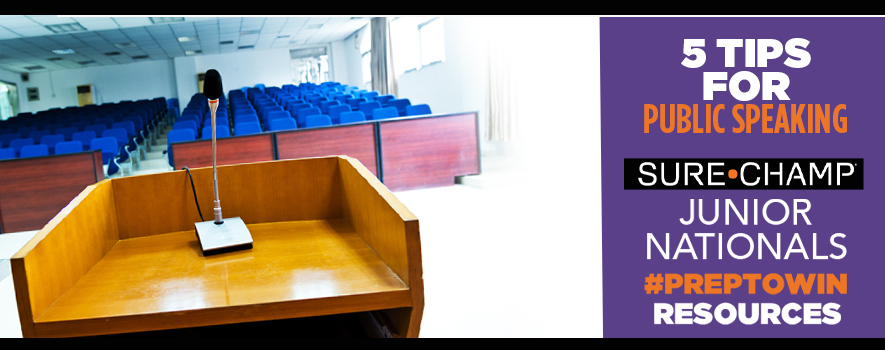
Public speaking. Just the very words can make some tremble to their core. For many, speaking in front of their peers or a small group of strangers is a huge fear that may be very challenging to overcome. However, when used effectively, public speaking is a useful tool in public relations and a great way to communicate your thoughts, ideas and feelings while connecting with others. Thankfully, livestock youth are provided with numerous opportunities to develop their speaking skills.
Whether it is prepared speaking competitions through FFA, demonstrations through 4-H clubs or a speaking contest at a Junior National – opportunities to fine tune your speaking skills await, and here are our top 5 tips to help you get ready!
Get Prepared…Ahead of Time
Regardless of if your speaking endeavor is a prepared speech or more of an impromptu scenario, you should always take some time to prepare. What does that mean? Your preparation should go beyond just practicing out loud in front of others. Before you get to that point, you should take some time researching topics you could speak on and selecting the one right for you. Or if it’s more of an impromptu situation, be sure you are familiar with several relatable and timely topics that you might speak on. This will help you feel more comfortable in what you are speaking about and more confident about your presentation.
Once you have done some preparation on your topic, it is time to do some organization of your thoughts. Take some time to think on the order in which you’d like to present your thoughts. This will often consist of an intro, a delivery of your key point, supporting details to help drive your point across and a conclusion. Lining this out on paper in an outline format will help you stay on target with what you are speaking about and will also make it easier for your audience to follow. If the contest rules allow, it is also good to have your outline on a few 3×5 notecards, just in case you do forget something while in front of your audience, you can glance down to get back on track. However, don’t rely too heavily on your notes for a crutch or it will appear like you are reading your speech!
Practice, Practice & PRACTICE
Now that you have your ideas outlined and a structure to follow, it is time to actually speak out loud! A good starting point might be talking through it to yourself to get more familiar with the flow. But remember, the best presentation won’t sound too rehearsed or memorized. So, it is important to be prepared with what you want to say, but still natural in the way you deliver it.
Once you feel comfortable with saying it out loud to yourself, try recording it on a phone or camera. Recording yourself helps you see what you sound like AND look like. You might not be loud enough; you might be too loud. You might have a fidgety hand; you might look too stiff. Seeing these things for yourself before practicing in front of others gives you time to work to improve them before you have a true trial run!
Lastly, get some practice in front of a mock audience. If you are nervous, start with a small group, maybe a parent or an advisor. Get their feedback and work on improving before you take on a larger group. As you improve, add a few more people to listen to get comfortable with more of an audience and more feedback on how you are doing.
Dress to Impress
When it comes to any speaking opportunity, first impressions are key. Make sure you understand the audience you are speaking to, and dress accordingly. While you should always dress in semi-professional attire, certain situations might call for something a little different. For example, if you are giving a prepared speech on beef cattle production, you might wear starched jeans, a nice shirt and your boots. Whereas a prepared speech about business ethics, might call for kakis or slacks and dress shoes instead.
Know your Environment, Know your Audience
As you get into the room, it is important to do some quick assessments to tailor your final presentation. First, survey the room. If it is a small space, you may need to modify and lower your volume. If it is a large room, you may need to speak up or even ask for a microphone if necessary. The size of the room can also dictate how much you can move about while speaking. If you prefer to pace some back and forth in between sections of your speech, the size of the room can impact what that movement pattern looks like.
Not only should you assess the room, you should also get to know your audience. Beforehand, try doing some research of who you will be presenting to, so you know the general population of those who will be listening. This will help you tailor what you choose to talk about. It is also important to gauge the audience’s reaction as you begin speaking. Watch their faces and their reactions to what you are saying. This can be helpful with either modifying your volume or expressions or throwing in some humor every now and then to loosen up the crowd. Knowing your audience and how to appeal to them will help you knock your final presentation out of the park!
Relax, Deliver and PERFORM
While it might be cliché and “easier said than done,” performing with confidence is the best piece of advice you can receive. As you get into the room, take a deep breath and relax before you dive into your speech. Take a moment to collect your thoughts and reflect on the basic outline of what you will be speaking on. When you speak, speak strongly with good eye contact to your audience, this helps you take command of the room. Most of all, remember that you have taken the time to prepare and practice and you are READY to deliver. And if you stumble or faulter slightly – don’t let it show! Push through with a smile on your face and jump to the next thing…because at the end of the day, those you are speaking to don’t know what you had planned in the first place.
Public speaking can be challenging to overcome and there’s no question that becoming skilled at it will take practice, time and effort. But it is a skill worth learning that will help you #PreptoWin in LIFE!

